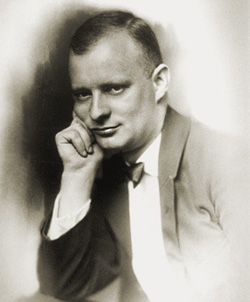Paul Hindemith
| Born | 16 November 1895
Hanau, German Empire
|
|---|---|
| Died | 28 December 1963 (aged 68)
Frankfurt, West Germany
|
| Education | Dr. Hoch’s Konservatorium |
| Occupations |
|
| Organizations |
|
| Works | Compositions |
| Awards |
|
Paul Hindemith (/ˈpaʊl ˈhɪndəmɪt/ POWL HIN-də-mit; German: [ˌpaʊ̯l ˈhɪndəmɪt] ; 16 November 1895 – 28 December 1963) was a German and American composer, music theorist, teacher, violist and conductor. He founded the Amar Quartet in 1921, touring extensively in Europe. As a composer, he became a major advocate of the Neue Sachlichkeit (New Objectivity) style of music in the 1920s, with compositions such as Kammermusik, including works with viola and viola d’amore as solo instruments in a neo-Bachian spirit. Other notable compositions include his song cycle Das Marienleben (1923), Der Schwanendreher for viola and orchestra (1935), the opera Mathis der Maler (1938), the Symphonic Metamorphosis of Themes by Carl Maria von Weber (1943), and the oratorio When Lilacs Last in the Dooryard Bloom’d (1946), a requiem based on Walt Whitman’s poem. Hindemith and his wife emigrated to Switzerland and the United States ahead of World War II, after worsening difficulties with the Nazi German regime. In his later years, he conducted and recorded much of his own music.
See More :

Paul Hindemith was the most important German composer in the inter-war years. He studied violin in Frankfurt, and after his father´s death in 1915 joined the orchestra of the Frankfurt Opera. He also supplemented the family income with private teaching and by playing in taverns and cinemas. He kept this practical approach to music all his life, performing on violin or viola as soloist or in various chamber ensembles. He organised music festivals, taught in Germany, USA and Turkey and later began a new career as conductor. Hindemith´s music draws on a wide variety of historical and contemporary styles. He developed his own completely unique system for understanding and composing music, based on the ranking of intervals of the 12-tone scale according to how dissonant they are. The most direct application of this theory is the large piano work Ludus Tonalis, containing 12 fugues with interludes – Hindemith´s response to Bach´s Das Wohltemperierte Clavier. He also wrote three piano sonatas, several other piano pieces for two or four hands, and sonatas with piano for almost every instrument of the orchestra.
Hindemith about himself:
“As a violinist, violist, pianist and percussionist I have thoroughly cultivated the following musical fields: chamber music of all kinds, cinema music, coffee house music, dance music, operetta, jazz band, and military music.”
| Title | Key | Year | Level | |
|---|---|---|---|---|
All pieces: |
||||
| Piano Suite Op. 26 | N/A | 1922 | 8+ | |
Source by: pianosintheparks.com



Leave a Reply
Want to join the discussion?Feel free to contribute!